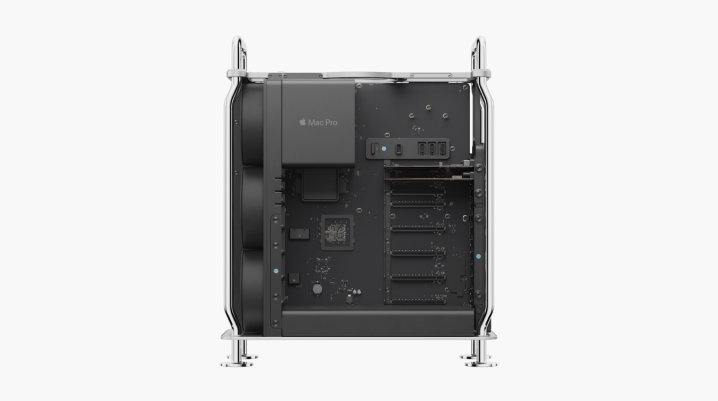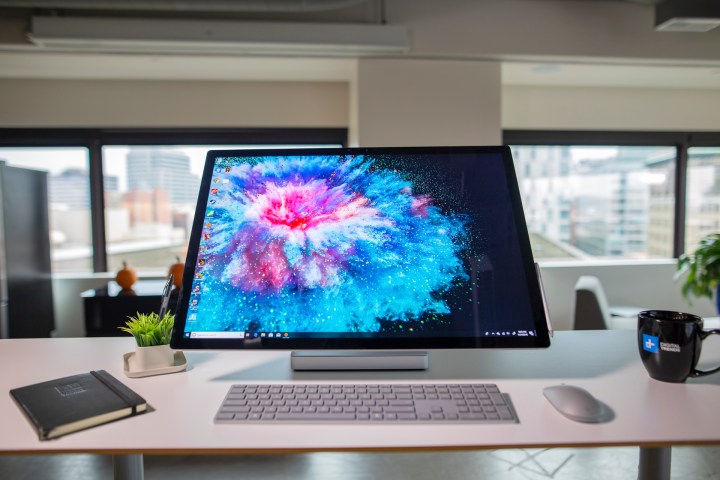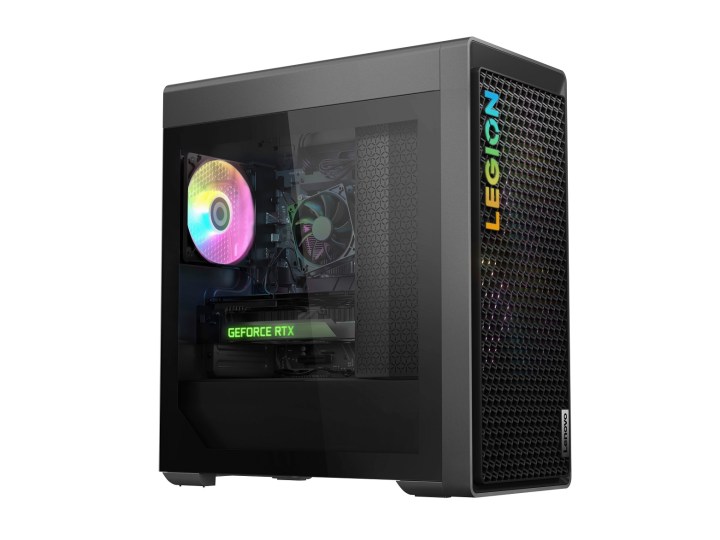So much content online today relies on having good video editing, but doing a proper job of it, especially when dealing with higher-resolution and bitrate sources, can be a little bit difficult on a phone or tablet. Luckily, there are a lot of great options when it comes to desktop PCs, with price ranges and specs going from budget to prosumer, depending on your needs. To that end, we’ve gone out and collected our favorite picks for the best desktop PCs for video editing, so be sure to check out them all out below, and if none of these really tickle your fancy, it might be worth checking out these great desktop computer deals as well.
The Best Desktop PCs for Video Editing
- Buy the if you want the best overall desktop PC for video editing
- Buy the if you want the best Apple desktop PC for video editing
- Buy the if you want the best small desktop PC for video editing
- Buy the if you want the best all-in-one desktop PC for video editing
- Buy the if you want the best budget desktop PC for video editing
ThinkStation P620 Tower Workstation
Best overall desktop PC for video editing

| Pros | Cons |
| Best performance you can get | Very pricey |
| Packed with high-end specs | Only has a 2TB SSD |
If you’re looking for the best desktop PC for video editing, then this Lenovo ThinkStation P620 Tower Workstation is very hard to beat, having professional-grade specs that are very hard to beat. Of course, that does mean that it comes at a very steep price, and if you want to pick this up, it’s going to be an investment. Even so, if you’re doing video editing at a professional level, then it makes sense to put money into something this high-end that will bring you up to the next level of video editing.
For starters, you get an AMD Ryzen Threadripper PRO 5955WX Processor CPU, which is actually a step above the consumer-grade CPUs like the Ryzen R9 and Intel i9, so you’re getting a lot more performance than you’d get by going and picking up a CPU from a big box store. As if that wasn’t enough, you also get the NVIDIA RTX A4500, which you may not be familiar with if you’re used to gaming GPUs, but it’s a professional-grade graphics processor with a whopping 20GB of VRAM. That’s perfect for video editing since it relies heavily on having a lot of VRAM to draw from as you’re actively using your favorite video editing program.
You’ll also be very impressed with the whopping 64GB of RAM that it has, although it is only DDR4, which isn’t a dealbreaker, but given the price we would have liked to see it be DDR5. Also, one other rather big letdown is the fact that it only comes with a 2TB SSD, which you’ll quickly run out of, especially if you’re dealing with large 4k or even 8k files. That said, you could always increase the internal storage down the line, so if you’re happy with the specs and price otherwise, then it’s absolutely worth grabbing this beast if you want to take your video editing to the next level.
| Specifications | |
|---|---|
| CPU | AMD Ryzen Threadripper PRO 5955WX Processor |
| GPU |
NVIDIA RTX A4500 20GB GDDR6 |
| RAM | 64 GB DDR4 |
| Storage | 2TB SSD |
Mac Pro
Best Apple desktop PC for video editing

| Pros | Cons |
| Incredible performance | Very pricey |
| Lots of optimized apps for MacOS | |
Many video editor’s pipelines are within the Apple ecosystem, and that makes sense given how many well-optimized video-editing apps exist for macOS. So, if you want one of the best bits of hardware within the Apple ecosystem, then the Mac Pro is the way to go, although it does come at a significant cost to do so. Also, it’s worth noting that, unlike previous versions, the new Mac Pro doesn’t have any configuration options outside of using Apple’s own M2 chips, so if you wanted to get an Intel-based configuration, you’re sadly out of luck.
Luckily, the M2 chip that you get is pretty powerful, and in this case, it’s the M2 Ultra, which, if you aren’t familiar, is essentially two M2 Max chips stitched together, so it’s probably one of the most powerful chips on the market. To give you an idea, it’s about three times faster when it comes to video editing compared to the last generation of Intel-based Mac Pros. Just reading off the specs of the M2 Ultra chip is impressive: It has 24 CPU cores, up to 76 GPU cores, and up to 192 unified RAM, all depending on which configuration you’d like to go for.
As for storage, the base configuration starts you out with 1TB, but you can get up to 8TB if you feel like it, although that is going to cost you an extra whopping $1,200. Similarly, you can have Final Cut Pro pre-installed, although that’s going to cost you an extra $300 as well. Ultimately, there are some incredible specs you can get out of the Mac Pro, but you will have to pay quite a steep price for it, as the most decked-out build with everything on it will run you a whopping $12,100, which is probably more than most people would be willing to spend if they aren’t doing video editing at the professional level.
| Specifications | |
|---|---|
| CPU | M2 Ultra |
| GPU |
M2 Ultra |
| RAM | Up to 192 GB |
| Storage | Up to 8TB |
Mac Studio
Best small desktop PC for video editing

| Pros | Cons |
| Very small given the performance | Can get very expensive depending on the specs you go for |
| Has a few great configurations | |
While desktop PCs are great and can offer a ton of great internal specs, they’re often massive and heavy things that can be hard to fit in a small office or workspace. Luckily, there is an excellent small form factor alternative in the form of the Mac Studio, and if your workflow is within the Apple ecosystem, then we’re sure you’re very happy with that. Also, one big positive of the Mac Studio is that you have a bit more leeway in terms of what sort of chip you want to run, and while that doesn’t include something Intel-based, it’s still a nice addition.
In terms of performance, you get a choice between having an M2 Max chip or an M2 Ultra chip, which is great given that the M2 Max chip configuration starts at $1,999 vs the M2 Ultra which starts at double that, so if you’re looking for something a bit more affordable, then you’ll want to go for the M2 Max option. On the other hand, if you want something to handle multiple 8k streams, then you’ll want to go with one of the M2 Ultra configurations, although you had better be prepared to pay a pretty penny.
In terms of what you can get the M2 Max configuration gives you 12 CPU cores, up to 38 GPU cores, up to 64GB of RAM, and up to 8TB of storage. The M2 Ultra options are the same as the Mac Pro, which includes 24 CPU cores, up to 76 GPU cores, up to 192GB of RAM, and up to 8TB of storage. Whichever configuration you end up grabbing won’t change the size of the Mac Studio, which is great, since it’s 7.7 x 7.7 x 3.7 inches, so it’s actually pretty tiny and easy to fit in most spaces. Also, you won’t miss out on ports since it’s smaller than a desktop as you get up to four USB ports and up to six Thunderbolt ports, depending on which configuration you go for, as well as an HDMI port, a 10Gb Ethernet port, and a 3.5 mm headphone jack
| Specifications | |
|---|---|
| CPU | M2 Max or M2 Ultra |
| GPU |
M2 Max or M2 Ultra |
| RAM | Up to 192 GB |
| Storage | Up to 8TB |
Microsoft Surface Studio 2+
Best all-in-one desktop PC for video editing

| Pros | Cons |
| Exceptional design, build quality | Overpriced for an older processor |
| Great graphics performance | Niche appeal |
| Starts at 16GB of RAM | Only has 6GB of VRAM |
Another option you can opt for if you want something that’s going to take up a lot less space is an all-in-one option, and for that, the Microsft Studio 2+ is probably the way to go. Of course, it’s important to note that with something like an all-in-one solution, you aren’t going to get the best specs out there, and while the Studio 2+ is certainly capable, it isn’t going to compete with the previous options on this list. That said, the lower specs aren’t necessarily a deal breaker, especially if you want something that’s a bit more versatile and that takes up a lot less space than having to buy a desktop and a monitor at the same time.
In terms of processing power, you get the Intel Core i7-11370H, which is a great mid-to-high-end CPU that will handle video editing tasks pretty well, although it might struggle with something a bit higher-end, like with 8k videos. It also comes with a GeForce RTX 3060, which will certainly help with video editing and graphical rending work as well, so it’s a nice addition for an all-in-one, which you don’t often find. You also get 32GB of RAM, which is similarly rather rare in all-in-one solutions, but is great for video editing and other tasks like programming or CAD work.
The screen is a massive 28-inch monitor running a whopping 4500 x 3000 resolution with a 10-point multi-touch touchscreen, which is great for those who prefer a touch-based experience. It also comes with a 1TB SSD, which is a bit on the lower end for video editing, although you could always expand it with one of these external hard drive deals. You’ll also be happy to know that it comes with the Surface Pen which gives you an excellent pen experience, as well as the Surface Keyboard and Mouse, which are also relatively good for video editing.
| Specifications | |
|---|---|
| CPU | Intel Core i7-11370H processor |
| GPU | GeForce RTX 3060 Laptop GPU with 6GB GDDR6 |
| RAM | 32 GB DDR4 |
| Storage |
1 TB |
Legion Tower 5i
Best budget desktop PC for video editing

| Pros | Cons |
| Excellent price | Only has an 8GB of VRAM |
| Pretty good video editing performance | Storage size is on the smaller end |
While it’s not the ideal option when going for a video editing setup, if you want something a bit more budget-friendly, then you might want to consider something like the Legion Tower 5i, which is a mid-range gaming PC and does have some good specs. In fact, it’s very similar to the Surface 2+ with a slightly better GPU and a good option if you already have peripherals like a good screen, mouse and keyboard. It’s also a more versatile option if you want to do things like productivity, graphic rendering, programming and things of that nature, plus it looks pretty great.
Under the hood, you’ll find an Intel Core i7-13700F, a good mid-to-high-end processor and it should handle most video editing tasks fairly well, although, again, it may struggle with higher-end stuff like multiple streams of 8K video. Luckily, it does have an RTX 4060 Ti GPU with 8GB of VRAM, which isn’t a ton for video editing, but it’s not bad either, especially for a budget option, plus it’s actually a pretty solid 1080p gaming GPU and good for graphical rendering. As for RAM, you do get the faster 16 GB of DDR5, and it should be good for other stuff like programming or CAD work, so we’re certainly happy with it given this is a budget option.
The only big downside here is that you only get a 512GB SSD, and while there is a fast 1TB HDD for storage, it’s not really ideal when doing something like video editing. That said, it’s not a deal breaker, and it should work when starting out, you’ll just likely have to upgrade it at some point down the line, which isn’t too difficult. Also, while not important, a fun little addition if you’re a gamer is that the Legion Tower 5i comes with with three months of Xbox Game Pass for free.
| Specifications | |
|---|---|
| CPU | Intel Core i7-13700F |
| GPU | NVIDIA GeForce RTX 4060 Ti 8GB GDDR6 |
| RAM | 16 GB of DDR5 |
| Storage |
512GB SSD + 1TB HDD |
How We Chose These Desktop PCs for Video Editing
CPU & GPU
It’s probably not a surprise that performance plays a big part when it comes to video editing, although a lot of how much performance you need relies on the sort of resolution you’re going to be editing. For example, editing 2K sources is going to require wildly different resources than editing multiple 8K sources, so there is actually quite a bit of leeway in terms of the sort of CPUs and GPUs we’d suggest.
That said, when it comes to CPUs, the higher the model the better, since they tend to have more threads and cores which video editing apps rely on. That’s why we mostly aimed for Intel Core i7 and AMD Ryzen R7 or better, since there are the baseline of what you’d need to edit video without struggling constantly. The good thing is that if you don’t need to do 8K video editing, then going with a lower and more budget-friendly option isn’t a problem, especially since video editing PCs can be exceedingly expensive at the higher end.
As for GPUs, they also play a part in the quality of video editing, but rather than it being about the specific power of the graphics card, it’s more about the Video RAM, or VRAM, that it has. Something with a 2GB of VRAM is not going to be a lot, and even 6GB might struggle to handle higher-end resolutions. Luckily, most options on the list have more than 6GB of GDDR6 VRAM, so you can pick whichever capacity works best for the sort of videos you plan to be editing.
RAM
Normal system RAM also plays a part in having a smoother experience, although not as much as CPU power or GPU RAM, so you don’t have to worry about this one as much. Even better, most modern systems tend to run either 8GB or more, and all of the choices above run 16GB or more as a minimum so you’re safe there. That said, there may be some advantages to having DDR5 RAM over DDR4, but at this point in time, it’s not going to be that big so we wouldn’t stress it if you find something you like with the older DDR4 standard.
Storage
While it may not be immediately obvious, having good storage is important for video editing if there is no other reason than the fact that most footage you’re likely going to be working with is going to be quite big. That’s especially the case if you’re working with 4K or 8K content, which can easily run several gigabytes per minute depending on the sort of bitrate you’re working. Beyond just that, having fast storage is important, especially if you’re working with lots of smaller files, which you likely are, and so you don’t want to spend a ton of time having to wait for clips and things to load in.
To that end, we did our best to not only have picks with SSD storage, but that have at least one TB of storage, and we often did our best to aim for more. The only option from above that doesn’t have that is the budget option, and that’s to help keep the price down. Luckily, storage upgrades are one of the easiest things you can do on your own, even with minimal tech-savvy, so even if the option you want doesn’t have as much storage as you’d like, you can always upgrade it on your own later on.
This article is managed and created separately from the Digital Trends Editorial team.



